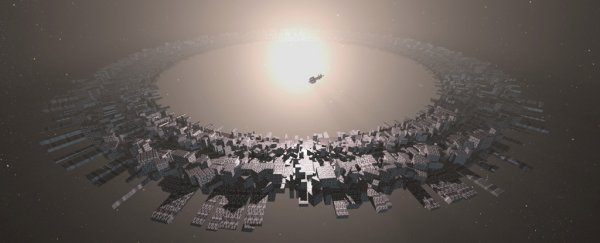The strangest and most mysterious star in the Universe goes by a lot of different names, but the boldest one of them all may soon have to be retired.
KIC 8462852 aka Tabby's Star aka Boyajian's Star is also known by many as simply "the alien megastructure star" – in reference to the most exotic hypothesis seeking to explain the star's mystifying, ever-fluxing light.
Now, a new study of this perplexing space curiosity led by Tabby herself – astrophysicist Tabetha Boyajian from Louisiana State University, who helped identify the star's unusual behaviour in 2015 – says whatever we're dealing with here, it's certainly no alien megastructure.
KIC 8462852 was first observed as long ago as the 19th century, and was catalogued in numerous astronomical surveys after that.
But the star first shot to greater prominence in 2015, when Boyajian and fellow researchers reported something very strange that they'd found buried in data from readings taken by NASA's Kepler space observatory.
All stars twinkle. On Earth, they appear to do so because of the way their starlight interacts with our planet's atmosphere.
But even in space the light stars project can vary, as things like planets pass in front of them, causing their starlight to dim ever so slightly as we observe them, often by around 1 percent (incidentally, this phenomenon is actually how we find a lot of exoplanets).
KIC 8462852 was different. Boyajian and her team found the dimming from this otherwise unremarkable star sitting some 1,280 light-years away wasn't slight at all – it was huge.
The changes in brightness emanating from Tabby's Star led to dimming of up to 22 percent, and these dips in starlight didn't seem to follow any particular pattern – like the periodic orbiting of planets around a star, for example – but were irregular.
This led some to hypothesise the dimming could be due to some kind of alien megastructure surrounding the star – something like an energy-absorbing Dyson Sphere, perhaps – that was built up around KIC 8462852, intermittently obstructing its light from reaching us.
Not all explanations were so fanciful. Some thought the dipping could be due to swarms of comets, others said interstellar junk.
Some mused it might be the star's own internal stellar conditions causing the variations, while one team went as far as to suggest KIC 8462852 had swallowed a planet, and the light fluxing was caused by planet crumbs.
While scientists were musing on the possibilities, a team of astronomers ended up successfully crowdfunding on Kickstarter a year's worth of observatory time to investigate KIC 8462852 – with researchers thinking it might throw up some clues if they had a chance to examine the dipping as it happened.
"We were hoping that once we finally caught a dip happening in real time we could see if the dips were the same depth at all wavelengths," explains one of the team, Jason Wright from Penn State University.
"If they were nearly the same, this would suggest that the cause was something opaque, like an orbiting disk, planet, or star, or even large structures in space."
But that's not what happened.
Four distinct episodes of dimming were recorded by the researchers at the Las Cumbres Observatory in California between March 2016 to December 2017, and a multispectral analysis of KIC 8462852's starlight revealed the star got much dimmer at some wavelengths than at others.
"The new data shows that different colours of light are being blocked at different intensities," says Boyajian.
"Therefore, whatever is passing between us and the star is not opaque, as would be expected from a planet or alien megastructure."
But while the most exotic explanation for KIC 8462852's fluxing starlight may have been ruled out for now – at least, to the extent that we understand Kardashev Scale alien technologies (which isn't much) – that doesn't mean Tabby's Star is a no-brainer all of a sudden.
KIC 8462852 might not be the alien megastructure we dared to dream it could be – but we still don't know what's causing the star's light to dim and dip.
It could be dust, comets, interstellar junk, who knows what else?
"This latest research rules out alien megastructures, but it raises the plausibility of other phenomena being behind the dimming," Wright explains.
Just what those phenomena are, we don't yet know for sure, but you can bet scientists won't rest until we have the answers.
The findings are reported in The Astrophysical Journal Letters.
